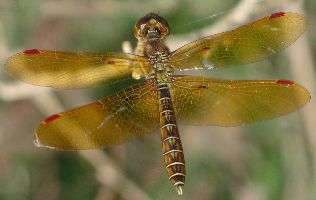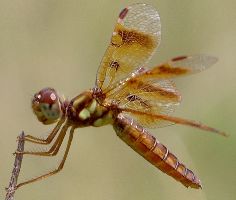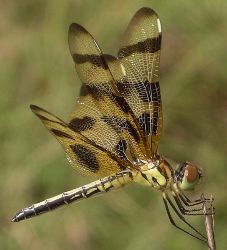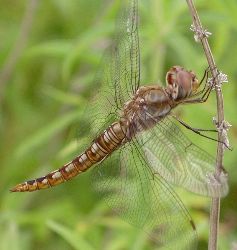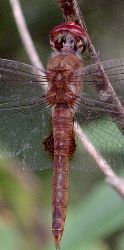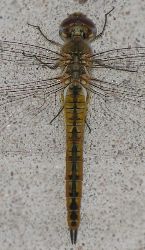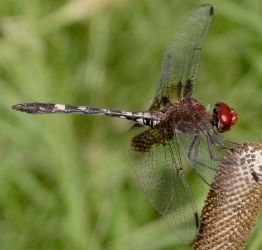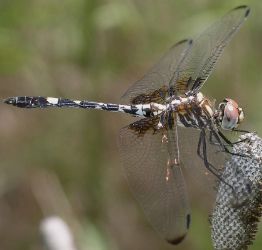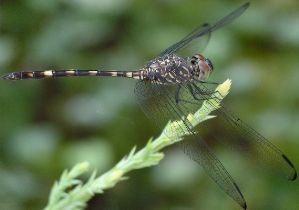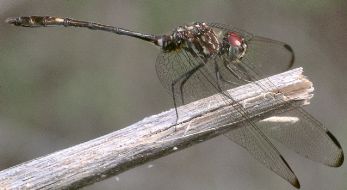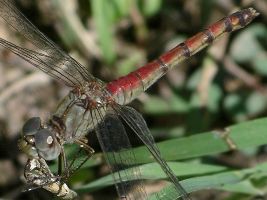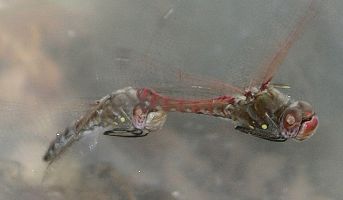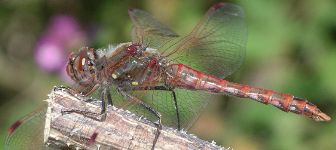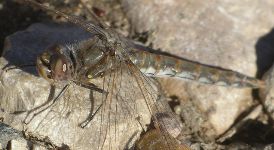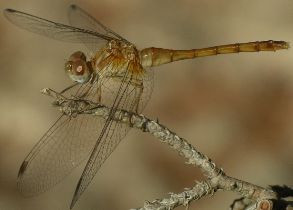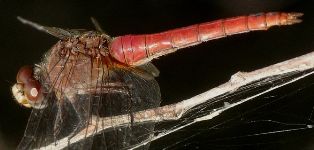
| Libellulidae ~ Skimmers |
|
The smallest dragonfly in our area is the charming Eastern Amberwing (Perithemis tenera), which barely reaches 25 mm in length. This stubby little skimmer is a wasp mimic, complete with orange and brown stripes on the suggestively swollen abdomen and a pair of light-colored spots on the side of the thorax, resembling those found on some sphecid wasps. Female Eastern Amberwings have brown spots on their wings while the wings of males are mostly unmarked gold.
The Halloween Pennant (Celithemis eponina) is intricately marked, both on the body and the wings. Both genders are similar in coloration. The colors range from light yellow to orange with darker markings. This species often rests on thin perches, much like the Eastern Amberwing, and allows its wings to wave like flags in the breeze.
Considered by some to be the most highly evolved dragonfly species, the gliders are certainly the most widespread. They have very wide wings made for sustained flight. Their abdomens taper towards the tip and they have a yellowish or golden brown color. The genders are similarly colored. The Spot-winged Glider (Pantala hymenaea) has a very small basal spot on the hind wings. This is nearly impossible to see from the side, as the wing folds down slightly and hides the mark. When young, the abdomen is marked with gold, brown and white. Mature individuals turn a darker solid brown color, with reddish eyes. The other glider in our area is the Wandering Glider (Pantala flavescens). With similar abdominal markings to the Spot-winged Glider, the main way to distinguish it is by the lack of spots on the wings. The setwings are named because of the manner in which they hold their wings: pushed forward in front of their head, as if "set" to take off. Other dragonflies sometimes hold their wings this way, but the setwings do it more consistently and more pronounced. As a group, they have slender abdomens and perch horizontally, never vertically, often holding their abdomen up in a slight arch.
The Checkered Setwing (Dythemis fugax) is indeed checkered with black and white. However, so are the other two species in our area, and the differences in the patterns are so subtle that they are quite difficult to use. There are differences in the stripes on the sides of the the thorax, but these are often hidden by the wings. Luckily, there are other clues to identity, and for the Checkered Setwing the best ones are the dark bases to the wings. The tips of the wings also often have a bit of dark color. Mature males develop a brown thorax and red eyes and face, while immature males look much like females but with more slender abdomens.
Mature male Black Setwings (Dythemis nigrescens) are quite easy to recognize, as they are a stunning steel blue black with black eyes and face. The wings are clear. Females, though, have brown and tan markings, much like the other setwings. Their face has just a small dark blue spot which is difficult to see. The wings often have some brown at the bases and tips. The pattern on the sides of the abdomen is sort of streaked looking, which helps a little. Immature male Black Setwings have markings similar to females, with the same brown eyes, but more slender abdomens.
The third species of setwing is the Swift Setwing (Dythemis velox). It also has dark and tan markings. Males have a slender and mostly dark abdomen and reddish eyes. There is often a bit of dark coloration on the bases and tips of the wings. Females are similar with more white markings on their thicker abdomen. I've only seen the Blue-faced Meadowhawk (Sympetrum ambiguum) once, and that was a female with coloration similar to males. This species is distinguished by the gray thorax, face and eyes. The abdomen has red with black rings. Some females are brown instead of red.
During the cooler months, the Variegated Meadowhawk (Sympetrum corruptum) is one of the more common species seen flying. I've even seen them in tandem as the female lays eggs during November! This species is on the small side, and rather compact in appearance. They are possibly wasp mimics, as both genders have two yellow spots on the sides of the thorax, usually signaling to predators a similarity to sphecid wasps.
The abdomen pattern of the Variegated Meadowhawk is complex, with a combination of checker markings in red, white and gray on the male, and just gray and white on the female. The red is not usually very intense, but more dull in color. Sometimes the pattern is clear and other times it is rather blurred or muddy looking. The thorax in both sexes is grayish and very fuzzy, a common trait amongst insects that fly during cold weather. The most common dragonfly during the coldest months, and often the only one flying in Dec.-Jan. at many ponds, is the Yellow-legged Meadowhawk (Sympetrum vicinum). This is one of the few dragonflies with a second common name: Autumn Meadowhawk. While the latter is more appropriate, the first was in use earlier. Male Yellow-legged Meadowhawks have a brown thorax and dull red abdomen, with a slight swelling at the base. As with the Variegated Meadowhawk, this dragonfly also has a fuzzy thorax, for heat retention.
Female Yellow-legged Meadowhawks are almost unmarked and their color is a golden brown. They sometimes look very translucent and delicate, especially young individuals. The base of the abdomen is swollen, which helps in identification, and the wings are clear with just a touch of amber color at the bases. One trait that also characterizes the female is her pointy ovipositor, which is visible on the underside of the abdomen tip.
One dragonfly that is easy to mix up with the Yellow-legged Meadowhawk is the Red-tailed Pennant (Brachymesia furcata). The females and young males are brown with a black stripe down the top of their abdomen. However, the males later have a red abdomen and so do some females. The shape of the abdomen, though, is a good clue to identification. Red-tailed Pennants have much thicker abdomens than Yellow-legged Meadowhawks. While the fuzzy thorax is about the same in both species, the face on female Red-tailed Pennants is white and is red on mature males, as opposed to the brownish colored face on Yellow-legged Meadowhawks. |
![]()
